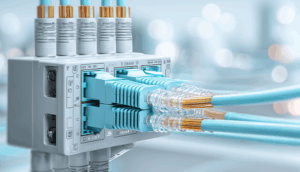High-Performance Computing (HPC) environments demand robust and reliable data communication infrastructure to support the intensive data transfer requirements of complex simulations, data analytics, and scientific research. Traditional network solutions can often become bottlenecks, hindering the overall performance and efficiency of HPC systems. This is where industrial Ethernet protocols like CC-Link IE come into play, offering significant advantages for data communication within and between HPC components.
CC-Link IE (Control & Communication Link Industrial Ethernet) is a high-speed, deterministic Ethernet protocol designed for industrial automation applications. Its key features, such as gigabit bandwidth, real-time communication capabilities, and robust error handling, make it well-suited for the demanding requirements of HPC. Unlike standard Ethernet, CC-Link IE utilizes a token-passing architecture that ensures predictable and reliable data delivery, which is crucial for applications requiring synchronization and coordinated processing across multiple nodes. This deterministic nature eliminates the potential for data collisions and network congestion, resulting in consistent and reliable performance even under heavy load.

In an HPC context, CC-Link IE can be utilized in several key areas. Firstly, it facilitates high-speed communication between compute nodes, enabling efficient parallel processing of large datasets. By providing a low-latency, high-bandwidth connection, CC-Link IE minimizes the communication overhead associated with distributed computing, allowing HPC clusters to achieve optimal performance. Secondly, CC-Link IE can be used to connect data acquisition systems to the HPC cluster, enabling real-time analysis of sensor data and other inputs. This is particularly useful in applications such as weather forecasting, fluid dynamics simulations, and materials science research, where timely processing of real-world data is essential.
Furthermore, CC-Link IE’s robust error handling capabilities ensure data integrity and reliability, even in harsh industrial environments. HPC systems are often deployed in data centers with fluctuating temperatures and potential electromagnetic interference, which can compromise the performance of standard Ethernet networks. CC-Link IE’s built-in error detection and correction mechanisms minimize the risk of data corruption, ensuring the accuracy and validity of computational results. This is particularly important for critical applications such as drug discovery and financial modeling, where errors can have significant consequences.

In conclusion, CC-Link IE offers a compelling alternative to traditional Ethernet solutions for HPC environments. Its high bandwidth, real-time communication capabilities, deterministic nature, and robust error handling make it an ideal choice for applications requiring high performance, reliability, and data integrity. As HPC systems continue to evolve and demand even greater data communication capabilities, industrial Ethernet protocols like CC-Link IE will play an increasingly important role in unlocking their full potential. Integrating CC-Link IE requires careful planning and configuration to ensure compatibility with existing HPC infrastructure, but the benefits in terms of improved performance and reliability can be substantial. Future research may explore the optimization of CC-Link IE implementations for specific HPC workloads and the integration of CC-Link IE with other advanced networking technologies.